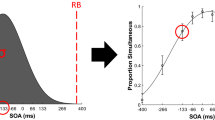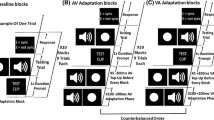Abstract
Musical training is associated with behavioral and neurophysiological enhancements in auditory processing for both musical and nonmusical sounds (e.g., speech). Yet, whether the benefits of musicianship extend beyond enhancements to auditory-specific skills and impact multisensory (e.g., audiovisual) processing has yet to be fully validated. Here, we investigated multisensory integration of auditory and visual information in musicians and nonmusicians using a double-flash illusion, whereby the presentation of multiple auditory stimuli (beeps) concurrent with a single visual object (flash) induces an illusory perception of multiple flashes. We parametrically varied the onset asynchrony between auditory and visual events (leads and lags of ±300 ms) to quantify participants’ “temporal window” of integration, i.e., stimuli in which auditory and visual cues were fused into a single percept. Results show that musically trained individuals were both faster and more accurate at processing concurrent audiovisual cues than their nonmusician peers; nonmusicians had a higher susceptibility for responding to audiovisual illusions and perceived double flashes over an extended range of onset asynchronies compared to trained musicians. Moreover, temporal window estimates indicated that musicians’ windows (<100 ms) were ~2–3× shorter than nonmusicians’ (~200 ms), suggesting more refined multisensory integration and audiovisual binding. Collectively, findings indicate a more refined binding of auditory and visual cues in musically trained individuals. We conclude that experience-dependent plasticity of intensive musical experience extends beyond simple listening skills, improving multimodal processing and the integration of multiple sensory systems in a domain-general manner.




Similar content being viewed by others
References
Anvari SH, Trainor LJ, Woodside J, Levy BA (2002) Relations among musical skills, phonological processing and early reading ability in preschool children. J Exp Child Psychol 83:111–130
Besson M, Chobert J, Marie C (2011) Transfer of training between music and speech: common processing, attention, and memory. Front Psychol 2:94
Bidelman GM (2013) The role of the auditory brainstem in processing musically-relevant pitch. Front Psychol 4:1–13
Bidelman GM, Alain C (2015) Musical training orchestrates coordinated neuroplasticity in auditory brainstem and cortex to counteract age-related declines in categorical vowel perception. J Neurosci 35:1240–1249
Bidelman GM, Krishnan A (2010) Effects of reverberation on brainstem representation of speech in musicians and non-musicians. Brain Res 1355:112–125
Bidelman GM, Gandour JT, Krishnan A (2011a) Cross-domain effects of music and language experience on the representation of pitch in the human auditory brainstem. J Cogn Neurosci 23:425–434
Bidelman GM, Krishnan A, Gandour JT (2011b) Enhanced brainstem encoding predicts musicians’ perceptual advantages with pitch. Eur J Neurosci 33:530–538
Bidelman GM, Hutka S, Moreno S (2013) Tone language speakers and musicians share enhanced perceptual and cognitive abilities for musical pitch: evidence for bidirectionality between the domains of language and music. PLoS ONE 8:e60676
Bidelman GM, Schug JM, Jennings SG, Bhagat SP (2014a) Psychophysical auditory filter estimates reveal sharper cochlear tuning in musicians. J Acoust Soc Am 136:EL33–EL39
Bidelman GM, Weiss MW, Moreno S, Alain C (2014b) Coordinated plasticity in brainstem and auditory cortex contributes to enhanced categorical speech perception in musicians. Eur J Neurosci 40:2662–2673
Brandler S, Rammsayer TH (2003) Differences in mental abilities between musicians and nonmusicians. Psychol Music 31:123–138
Chartrand JP, Belin P (2006) Superior voice timbre processing in musicians. Neurosci Lett 405:164–167
Cooper A, Wang Y (2012) The influence of linguistic and musical experience on Cantonese word learning. J Acoust Soc Am 131:4756–4769
DeLoss DJ, Pierce RS, Andersen GJ (2013) Multisensory integration, aging, and the sound-induced flash illusion. Psychol Aging 28:802–812
Diederich A, Colonius H, Schomburg A (2008) Assessing age-related multisensory enhancement with the time-window-of-integration model. Neuropsychologia 46:2556–2562
Elbert T, Pantev C, Wienbruch C, Rockstroh B, Taub E (1996) Increased cortical representation of the fingers of the left hand in string players. Science 270:305–307
Erber NP (1975) Auditory-visual perception of speech. J Speech Hear Disord 40:481–492
Foss AH, Altschuler EL, James KH (2007) Neural correlates of the Pythagorean ratio rules. NeuroReport 18:1521–1525
Foss-Feig JH, Kwakye LD, Cascio CJ, Burnette CP, Kadivar H, Stone WL, Wallace MT (2010) An extended multisensory temporal binding window in autism spectrum disorders. Exp Brain Res 203:381–389
Foster NE, Zatorre RJ (2010) A role for the intraparietal sulcus in transforming musical pitch information. Cereb Cortex 20:1350–1359
Fritz J, Shamma S, Elhilali M, Klein D (2003) Rapid task-related plasticity of spectrotemporal receptive fields in primary auditory cortex. Nat Neurosci 6:1216–1223
George EM, Coch D (2011) Music training and working memory: an ERP study. Neuropsychologia 49:1083–1094
Giard MH, Peronnet F (1999) Auditory-visual integration during multimodal object recognition in humans: a behavioral and electrophysiological study. J Cogn Neurosci 11:473–490
Grahn JA, Rowe JB (2009) Feeling the beat: premotor and striatal interactions in musicians and nonmusicians during beat perception. J Neurosci 29:7540–7548
Herholz SC, Zatorre RJ (2012) Musical training as a framework for brain plasticity: behavior, function, and structure. Neuron 76:486–502
Ho Y, Cheung M, Chan A (2003) Music training improves verbal but not visual memory: cross sectional and longitudinal explorations in children. Neuropsychology 17:439–450
Kaganovich N, Schumaker J, Leonard LB, Gustafson D, Macias D (2014) Children with a history of SLI show reduced sensitivity to audiovisual temporal asynchrony: an ERP study. J Speech Lang Hear Res 57:1480–1502
Kaposvari P, Csete G, Bognar A, Csibri P, Toth E, Szabo N, Vecsei L, Sary G, Kincses ZT (2015) Audio-visual integration through the parallel visual pathways. Brain Res 1624:71–77
Kraus N, Chandrasekaran B (2010) Music training for the development of auditory skills. Nat Rev Neurosci 11:599–605
Kraus N, Slater J, Thompson EC, Hornickel J, Strait DL, Nicol T, White-Schwoch T (2014) Music enrichment programs improve the neural encoding of speech in at-risk children. J Neurosci 34:11913–11918
Lappe C, Herholz SC, Trainor LJ, Pantev C (2008) Cortical plasticity induced by short-term unimodal and multimodal musical training. J Neurosci 28:9632–9639
Laurienti PJ, Burdette JH, Maldjian JAW, Wallace MT (2006) Enhanced multisensory integration in older adults. Neurobiol Aging 27:1155–1163
Lee H, Noppeney U (2011) Long-term music training tunes how the brain temporally binds signals from multiple senses. Proc Natl Acad Sci USA 108:E1441–E1450
Lee HL, Noppeney U (2014) Music expertise shapes audiovisual temporal integration windows for speech, sinewave speech and music. Front Psychol 5:1–9
Lu Y, Paraskevopoulos E, Herholz SC, Kuchenbuch A, Pantev C (2014) Temporal processing of audiovisual stimuli is enhanced in musicians: evidence from magnetoencephalography (MEG). PLoS ONE 9:e90686
McGurk H, MacDonald J (1976) Hearing lips and seeing voices. Nature 264:746–748
Mishra J, Gazzaley A (2012) Attention distributed across sensory modalities enhances perceptual performance. J Neurosci 32:12294–12302
Mishra J, Martinez A, Sejnowski TJ, Hillyard SA (2007) Early cross-modal interactions in auditory and visual cortex underlie a sound-induced visual illusion. J Neurosci 27:4120–4131
Mishra J, Martinez A, Hillyard SA (2008) Cortical processes underlying sound-induced flash fusion. Brain Res 1242:102–115
Moreno S, Bidelman GM (2014) Understanding neural plasticity and cognitive benefit through the unique lens of musical training. Hear Res 308:84–97
Musacchia G, Sams M, Skoe E, Kraus N (2007) Musicians have enhanced subcortical auditory and audiovisual processing of speech and music. Proc Natl Acad Sci USA 104:15894–15898
Myers EB, Swan K (2012) Effects of category learning on neural sensitivity to non-native phonetic categories. J Cogn Neurosci 24:1695–1708
Neufeld J, Sinke C, Zedler M, Emrich HM, Szycik GR (2012) Reduced audio–visual integration in synaesthetes indicated by the double-flash illusion. Brain Res 1473:78–86
Novembre G, Keller PE (2014) A conceptual review on action-perception coupling in the musicians’ brain: what is it good for? Front Human Neurosci 8:603
Pallesen KJ, Brattico E, Bailey CJ, Korvenoja A, Koivisto J, Gjedde A, Carlson S (2010) Cognitive control in auditory working memory is enhanced in musicians. PLoS ONE 5:e11120
Pantev C, Roberts LE, Schulz M, Engelien A, Ross B (2001) Timbre-specific enhancement of auditory cortical representations in musicians. NeuroReport 12:169–174
Paraskevopoulos E, Kuchenbuch A, Herholz SC, Pantev C (2012) Evidence for training-induced plasticity in multisensory brain structures: an MEG study. PLoS ONE 7:e36534
Paraskevopoulos E, Kraneburg A, Herholz SC, Bamidis PD, Pantev C (2015) Musical expertise is related to altered functional connectivity during audiovisual integration. Proc Natl Acad Sci USA 112:12522–12527
Parbery-Clark A, Skoe E, Kraus N (2009a) Musical experience limits the degradative effects of background noise on the neural processing of sound. J Neurosci 29:14100–14107
Parbery-Clark A, Skoe E, Lam C, Kraus N (2009b) Musician enhancement for speech-in-noise. Ear Hear 30:653–661
Powers AR, Hillock AR, Wallace MT (2009) Perceptual training narrows the temporal window of multisensory binding. J Neurosci 29:12265–12274
Rammsayer T, Buttkus F, Altenmüller E (2012) Musicians do better than non-musicians in both auditory and visual timing tasks. Music Percept 30:85–96
Rosenthal O, Shimojo S, Shams L (2009) Sound-induced flash illusion is resistant to feedback training. Brain Topogr 21:185–192
Shahin A, Bosnyak DJ, Trainor LJ, Roberts LE (2003) Enhancement of neuroplastic P2 and N1c auditory evoked potentials in musicians. J Neurosci 23:5545–5552
Shams L, Kamitani Y, Shimojo S (2000) What you see is what you hear. Nature 408:788
Shams L, Kamitani Y, Shimojo S (2002) Visual illusion induced by sound. Cogn Brain Res 14:147–152
Slevc RL, Miyake A (2006) Individual differences in second-language proficiency: does musical ability matter? Psychol Sci 17:675–681
Stevenson RA, Wilson MM, Powers AR, Wallace MT (2013) The effects of visual training on multisensory temporal processing. Exp Brain Res 225:479–489
Stevenson RA, Siemann JK, Schneider BC, Eberly HE, Woynaroski TG, Camarata SM, Wallace MT (2014) Multisensory temporal integration in autism spectrum disorders. J Neurosci 34:691–697
Strait DL, Kraus N (2011) Can you hear me now? Musical training shapes functional brain networks for selective auditory attention and hearing speech in noise. Front Psychol 2:113
Strait DL, Kraus N, Parbery-Clark A, Ashley R (2010) Musical experience shapes top-down auditory mechanisms: evidence from masking and auditory attention performance. Hear Res 261:22–29
Sumby WH, Pollack I (1954) Visual contribution to speech intelligibility in noise. J Acoust Soc Am 26:212–215
Tierney AT, Bergeson TR, Pisoni DB (2008) Effects of early musical experience on auditory sequence memory. Empir Musicol Rev 3:178–186
van Vugt FT, Tillmann B (2014) Thresholds of auditory-motor coupling measured with a simple task in musicians and non-musicians: was the sound simultaneous to the key press? PLoS ONE 9:e87176
Vatikiotis-Bateson E, Eigsti I-M, Yano S, Munhall KG (1998) Eye movement of perceivers during audiovisual speech perception. Percept Psychophys 60:926–940
Wallace MT, Stevenson RA (2014) The construct of the multisensory temporal binding window and its dysregulation in developmental disabilities. Neuropsychologia 64C:105–123
Wong PC, Perrachione TK (2007) Learning pitch patterns in lexical identification by native English-speaking adults. Appl Psycholinguist 28:565–585
Wong PC, Skoe E, Russo NM, Dees T, Kraus N (2007) Musical experience shapes human brainstem encoding of linguistic pitch patterns. Nat Neurosci 10:420–422
Zatorre R, McGill J (2005) Music, the food of neuroscience? Nature 434:312–315
Zatorre RJ, Chen JL, Penhune VB (2007) When the brain plays music: auditory-motor interactions in music perception and production. Nat Rev Neurosci 8:547–558
Zendel BR, Alain C (2009) Concurrent sound segregation is enhanced in musicians. J Cogn Neurosci 21:1488–1498
Zuk J, Benjamin C, Kenyon A, Gaab N (2014) Behavioral and neural correlates of executive functioning in musicians and non-musicians. PLoS ONE 9:e99868
Acknowledgments
The author thanks Haley Sanders for assistance in data collection and Amy Fehrenbach for comments on earlier versions of this manuscript. This work was supported in part by a grant from the GRAMMY® Foundation awarded to G.M.B.
Author information
Authors and Affiliations
Corresponding author
Rights and permissions
About this article
Cite this article
Bidelman, G.M. Musicians have enhanced audiovisual multisensory binding: experience-dependent effects in the double-flash illusion. Exp Brain Res 234, 3037–3047 (2016). https://doi.org/10.1007/s00221-016-4705-6
Received:
Accepted:
Published:
Issue Date:
DOI: https://doi.org/10.1007/s00221-016-4705-6




